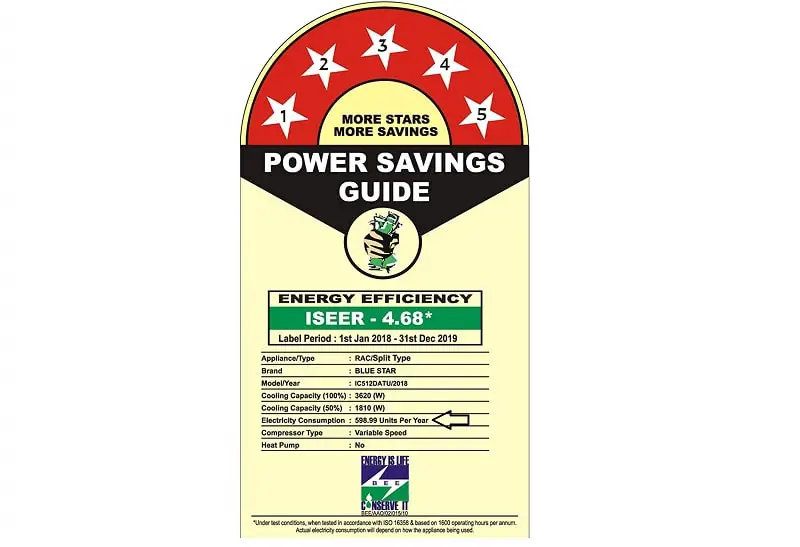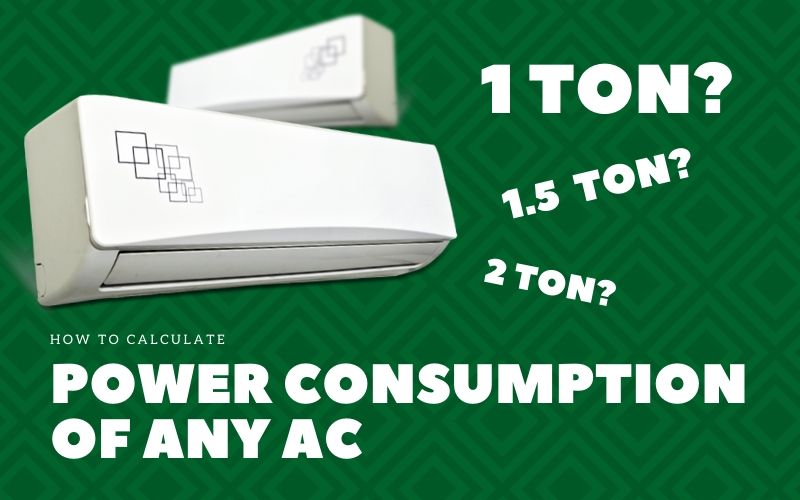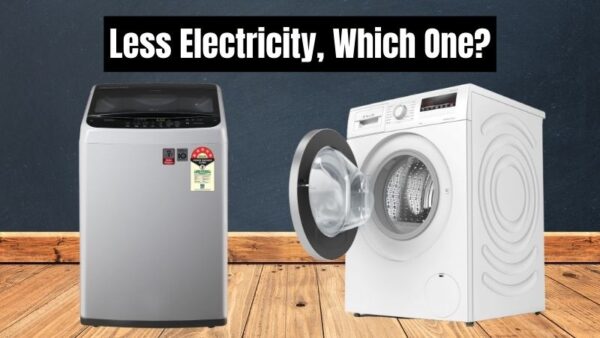What is the power consumption of my AC and how much electricity bill do I get for running my 1 Ton AC for 5 hours. If these question float in your head then you have come the right place. In this article we will see the power consumption of an air conditioner be it 1 Ton, 2 Ton, 3 Ton and also look at ways to reduce your AC power consumption and save some electricity bill.
Before we start with calculating power consumption of your AC let’s have a quick look into various factors that increase the power consumed by an AC.
Factors affecting AC power consumption:
- No of people in the room: Human body emits lot of heat, a room with 20 people will need bigger size AC or multiple ACs to cool the air inside it, whereas the same room with 3 people in it will get the same cooling for a smaller size AC or a single AC. So more people means more power hence more electricity bill.
- Outside & inside temperature: It takes more power to cool a room when outside temperature is 40 degree Celsius than when it is 32 degree Celsius. Likewise it takes more power to cool at room to 18 degree than to cool it at 24 degree Celsius.
- Room size: Air conditioners remove the heat from the air inside your room. Therefore, larger the room, larger is the volume of air inside it and more is the electricity required to cool that air. Electricity consumed in removing heat from a 100 sqft room is less than removing heat from a 200 sqft room.
- Electrical appliances in your room: Every electrical appliance in your room generates heat which increases your room’s temperature and makes your AC do additional work for cooling the same volume of air, hence more power consumption.
- Volume of air to be cooled: Often times we keep our cupboard doors open which increases the volume of air to be cooled by your AC. Now your AC has to cool the hot air inside your cupboard too which is unnecessary and consumes extra power.
- Objects in your room: Every solid object in your room gets cold when kept in AC, this is another unnecessary cooling your AC has to do.
Calculate power consumption of an AC from it’s label:
The easiest way to calculate your AC power consumption is by using the energy saving label on your AC.
If you look into your AC energy saving label it has annual power consumption for your AC.
Here I have pulled up energy saving label of a 1 Ton Split AC from Blue Star.

You can clearly see on the label the annual power consumed by this 1 ton AC is 589.99 kWh. This value is calculated in test condition with annual operational hours being 1600.
Which translates to 4.5 hours of operation every day, 133.33 hours of operation every month, which I feel is average daily operation for most households.
The actual value will mostly be higher than this value because of the high outside temperature than testing conditions and our inefficient habits of using AC.
This is the most simplest and accurate method to find an AC with least power consumption.
If your AC is old and does not have energy savings label on it then you can use the below method to calculate the power consumption of your AC.
If you are shopping for a new AC visit https://mannix.com.au/product-category/evaporative/ to choose more varieties of AC.
Calculate power consumption of an AC manually:
To manually calculate your AC power consumption you will need to know the following three things.
- The wattage of your AC – Watt is the unit of power. It means the rate at which electricity is consumed or produced by a device. For example a 50 watt electric fan consumes power at a rate of 50 watts per hour, it does not means that electric fan consumed 50 units of electricity, it means it will consume power at a rate of 50 watts every hour.
- Operational hours – Number of hours you are running your appliance, in this case air conditioner.
- Electricity tariff – Electricity tariff is the amount your electricity provider charges you for one unit (kWh) of electricity. I live in Mumbai, India here the electricity tariff is Rs 12/ kWh. Just put your areas electricity tariff in the calculator.
To understand the calculated result you should understand the following term.
- Kilowatt hour – Kilowatt hour (kWh) a.k.a units is the energy consumption of a device. For example a 50 watt electric fan running for 50 hours will consume 50 watt x 50 hours = 2500 watt hours = 2.5 kilowatt hours of electricity = 2.5 units of electricity.
As a general rule of thumb, for AC power consumption calculation you should take,
- 1 ton of cooling = 1,000 watts
- 1.5 ton of cooling = 1,500 watts
- 2 ton of cooling = 2,00 watts
- 3 ton of cooling = 3000 watts and so on.
Now use the below calculator to calculate your AC power consumption.
How To Interpret Calculated Result:
Whatever value you get just multiply it by two because your AC compressor is turned ON for only 50 % of the time whether you AC is conventional one or inverter AC.
So if you got 4 kWh of electricity then actual power consumption will be half of that which is 2 kWh.
The calculated result is an average value and it will go up if the outside temperature is high (like 40 degree Celsius) and inside temperature is too low (like 18 degree Celsius) and it will come down if the outside temperature is low (like 32 degree Celsius) and inside temperature is 22-24 degrees.
You will get a value which is only 5% inaccurate, but if you want to know your AC’s exact power consumption then there is a way for that too.
Calculate power consumption of an AC using Kill A Watt meter:
If you want to know exact power consumption of your AC then the most accurate way is to use a Kill A Watt meter.
Kill A Watt meter is a simple device which can be used to get accurate results on the power consumption of any device.
You can buy it from amazon using this link. Best Kill A Watt Electricity Usage Monitor
To calculate AC power consumption first connect your AC plug into the kill a watt meter and then plug the kill a watt meter in your wall socket and turn on your AC.
Then start using the AC and you can see in real time how many kWh (units) of electricity your air conditioner is using.
For appliances which have compressor like AC, refrigerator it is advisable to take the reading for 3-7 days to get exact power consumption.
So keep the AC plugged to the Kill A Watt meter for the whole week and note the final value at the end of the week this way you will get the most accurate value of your AC power consumption.
Check out this amazingly useful video from Tech Guy Charlie where he calculates power consumption of a 1.5 Ton inverter AC using Kill A Watt Meter.
Tips to reduce power consumption of AC:
- Set AC at 24 degree Celsius: Many a times we cool our room way below what is needed. Always remember idea of air conditioning is to cool your room to a comfortable temperature (22 – 26 degree Celsius) not freeze to death.
- Turn off appliances when not in use: Usually there are 5-10 appliances running in a room when the AC is running. Even the smallest of appliance dissipate heat which can heat up the cooled air quickly, so make sure you completely turn off the appliances which you don’t need and at best remove them from the room.
- Close doors & windows: AC removes heat from the air and cools it, if you open your rooms door again and again fresh stream of hot air will enter the room which needs to be cooled. Also if there are any cabinets in your room then please keep it closed otherwise the air inside the cabinet will also be cooled which is absolutely unnecessary use of electricity.
- Keep compressor & AC unit in shade: Make sure your AC does not receive direct sunlight, if it gets direct sunlight then try to avoid using that area or somehow try to avoid sunlight. Also keep the compressor unit in shade.
- Annual maintenance of air conditioner: Get your air conditioner checked every year by a professional. Refrigerant leakage, faulty compressor, low level of refrigerant can spike up the power consumption of your ac and degrade the cooling capacity. Hence you should get your AC checked at least once a year, this will surely give your AC longer life and maximum efficiency.
- Clean your AC filters: A filter full of dust acts as a barrier in the flow of air, which results in low air flow rate and makes the compressor work harder to pump fresh cool air which increases your ac electricity consumption, so keep the air filter clean.
You can read this detailed article on How to save electricity bill because of AC.
Planning to buy a new AC, check out the following list of most energy efficient AC available in 2020.
Top 5 most energy efficient AC to buy in 2020:
- Voltas 1 Ton 5 Star Inverter Split AC – Annual power consumption 617 units in a year for 1600 hours of operation. [Amazon Link]
- Blue Star 1 Ton 5 Star Inverter Split AC – Annual power consumption 599 units in a year for 1600 hours of operation. [Amazon Link]
- LG 1.5 Ton 5 Star Dual Inverter Split AC – Annual power consumption 835 units in a year for 1600 hours of operation. [Amazon Link]
- Voltas 1.5 Ton 5 Star Inverter Split AC – Annual power consumption 892 units in a year for 1600 hours of operation. [Amazon Link]
- Daikin 1.8 Ton 5 Star Wi-Fi Inverter Split AC – Annual power consumption 989 units in a year for 1600 hours of operation. [Amazon Link]
Conclusion on AC power consumption:
Most air conditioners in today’s time with energy savings stars and inverter technology compressor don’t consume much power.
1 ton air conditioner be it inverter or non-inverter consumes about 0.5 – 1 unit of electricity every hour depending on the operating conditions, which isn’t much keeping in mind the comfortable cooling experience AC’s give us especially during hot summer.
References for AC power consumption:
- https://www.samsung.com/
- https://www.lg.com/
- https://beeindia.gov.in/
- https://en.wikipedia.org/wiki/Bureau_of_Energy_Efficiency







Can you provide a kWh chart for ACs of different star ratings and tonnage.
Wao great….bhuat acha informatic topic hy….